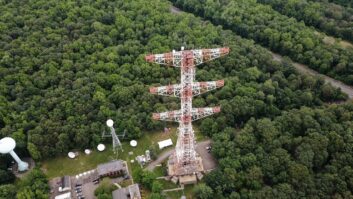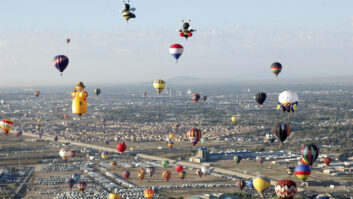Aviation obstruction lights are high-medium-, or low-intensity lighting devices installed atop high-rise structures, buildings and towers and used as collision avoidance measures.

The governments of most countries require aviation obstruction lights on all high towers and on low towers near airports, because towers are hazards to aircraft. Such devices make the structure much more visible to passing aircraft, and are usually used at night, although in some countries they are used during daytime, too. Aviation lights need to be of sufficient brightness in order to be visible for miles around the structure.
For broadcasters, high-rise towers are a vital part of the transmitting system, so proper understanding of tower lighting system is essential.
In general, tower lighting systems require several sets of lights, depending on the height and location of the tower, along with connection to the mains power supply. In addition, medium-wave broadcasters require some form of isolation system, such as an Austin transformer, on self-radiating towers.
Earlier, incandescent filament bulbs were standard for tower lighting, but nowadays LED-based and solar-powered LED-based aviation obstruction lights are very popular.
These lights have replaced older incandescent filament and neon bulbs for several reasons. An additional benefit for broadcasters is that solar-powered LED aviation obstruction lights can eliminate the need for power cabling and Austin transformers on self-radiating towers.
CATEGORIES OF LIGHTS
Aviation obstruction lights are broadly divided into three types: aviation red obstruction lights for structures less than 200 feet (61 meters) above ground level (AGL); medium-intensity flashing white obstruction lights for structures between 200 feet and 500 feet (153 meters) AGL; and high-intensity flashing white obstruction lights for structures with a height exceeding 500 feet AGL. A mix of these types of lights may be required, depending upon the tower.
Aviation obstruction lights must meet all specifications of the International Civil Aviation Organization (ICAO). Since rules can vary from nation to nation, additional approvals from other organizations may be required. In the United States, the Federal Aviation Administration is responsible for implementing aviation safety regulations.
In the Field AHMEDABAD, India — In July 2008, while attending to a fault of cabling and lights on the medium-wave mast at All India Radio Ahmedabad’s Bareja high-power transmission site, it was observed that the Austin transformer at the site was also faulty.
Looking at the exorbitant replacement cost of this transformer and cabling, the station decided to explore the other alternatives for obstruction lighting on the tower.
During its search, AIR Ahmedabad came across an excellent option: compact solar-powered LED aviation obstruction lights.
The solar-powered lights consist of a backup battery panel, high-intensity LED lights and control circuitry — all enclosed in a suitably designed compact iron-clad box.
The solar panel is rigidly attached to the box, making it a single module. With the help of clamps, the entire unit can be mounted on the mast or tower.
A setup like this had not previously been used on a live mast carrying RF voltage in excess of tens of thousands of volts. Some personnel were skeptical that the systems might burn out due to the high RF field, and the effect of a high-intensity RF field on the storage batteries was also not known.
As an experiment, one solar-powered LED aviation obstruction light was mounted on the mast at 3 meters above ground level (10 feet AGL); utmost care was taken to Any structure that exceeds 200 feet AGL generally needs to be marked/lighted according to FAA regulations. There are many factors that can affect obstruction marking requirements, such as weather, terrain, proximity to airports, etc.
Tower lighting can be red or white; specific colors may be mandated based on the tower size and location.
For red lighting systems, the tower must be painted in alternating sections of orange and white paint to provide maximum daytime visibility; red lights are for night-time use only. In the case of white or dual (red-white) lighting systems, the need for painting the tower may be eliminated.
A tower or any high-rise structure may be lighted by low-, medium- or high-intensity obstacle lights or a combination of such lights.
Multiple light units may be used to achieve a horizontal coverage of 360 degrees around the tower or structure. The “beam spread” of a light is defined as the angle between the two directions in a plane for which the intensity is equal to 50 percent of the minimum specified peak beam effective intensity.
Towers taller than 200 feet may also require lighting at intermediate points along the tower. The color and placement requirements can vary based on tower height. The presence of guy wires may also affect how a tower must be marked.
In addition to structure size, the type or combination of types of lights that must be used can vary based upon the time of day. Their type of signaling (fixed or flashing) and brightness also can vary. FAA Advisory Circular AC 70/7460-1K outlines the specific obstruction marking requirements.
TYPES OF LIGHTS
Traditionally, red lamps use incandescent filament bulbs or neon bulbs, which have a relatively short lifespan.
Nowadays, LED-based and solar LED-based lights are becoming quite popular.
Advances in light-emitting diode technology are creating new applications and increased acceptability of LEDs for mainstream applications. Until recently, LEDs were considered appropriate only for indication or decorative purposes, but LEDs are now gaining acceptance for signaling, down lights, floodlights, street lights and aviation obstruction lights.
LED light is increasingly superseding incandescent bulbs and neon lights, particularly for applications where the bulb can be difficult to replace, because an LED light source can offer a longer life, energy savings, equal or better light characteristics and years of maintenance-free operation and a quantifiable return on investment.
LEDs are common on broadcasting towers, mobile towers, wind turbines and high-rise buildings. Technical specifications of these lights are based on the number and type of LEDs used, and are usually defined in terms of lux produced. LED-based obstruction lights are available for all intensity types and categories.
In addition to being long lasting (LEDs can remain in service for a decade or more), LED technology is quite efficient at converting electrical energy into light energy while generating very little heat. LEDs are 90 percent more energy efficient than the incandescent bulb.
Also, since LEDs give off hardly any heat, they are safe to handle and there are no UV or infrared rays. They also are clearly visible in sunlight, without any time lag.
Unlike conventional light sources such as fluorescent and high-intensity discharge bulbs that use mercury to generate light, LED lighting uses no mercury, thus eliminating issues surrounding disposal of hazardous substances.
LEDs are also reliable and rugged; they contain no fragile filaments or glass. LEDs are solid-state devices and are less affected by the demands of harsh and hazardous environments. Finally, the usable life of LED bulbs is limited by lumen depreciation, not failure.
Lumen depreciation is the main concern with LED bulbs as their luminous intensity can significantly decrease over time. However, many manufacturers compensate for this by offering lights with initial luminous intensity much greater than required by FAA and ICAO specifications.
LEDs can also be heat-sensitive, and excessive heat buildup can shorten their usable lifespan.
SOLAR LED-BASED LIGHTS
The combination of a new generation of LED lights with very low power consumption and the falling costs of solar panels made it practical for LED-based obstruction lights to work on solar energy. This kind of system consists one solar panel, a backup battery, high-intensity LED lights and a control circuit.
In fact, this arrangement is very economical compared to other aircraft obstruction lighting (AOL) systems. These lights are suited for all types of tower, and avoid the necessity of laying mains power supply cables on the tower. Also, in case of self-radiating medium-wave towers, the costs of Austin isolation transformers are also saved.


Table 1: Comparison of Various Lights for Aviation Obstruction Lighting Among the other benefits of solar-powered LED-based obstruction lights are that each light operates independently; and accident or failure may affect one light, but it will not affect the others.
Also, with automatic sensors no manual intervention is required to turn the lights on or off. Solar lights can be designed to provide illumination automatically from dusk to dawn. Each system can charge itself, storing and producing electricity even on overcast days.
In addition to the light itself, solar-powered LED-based obstruction lights do require a few additional basic “modules” for operation.
A solar, or photovoltaic to use the formal term, module converts sunlight into electricity that can be used immediately or stored in a battery for use during the night. The type of battery being used is lead-acid, maintenance-free type, which is designed to be fully charged and discharged over and over again without causing damage.
Also necessary is a DC-to-AC inverter to convert direct current from the battery into alternating current to run AC appliances. If the LED lights are able to work on DC, then there is no need for converter.
Setting up a solar-powered LED-based obstruction lighting system does require some care, especially in positioning the solar panels to ensure maximum power generation.
Also, if a DC-to-AC inverter is used, remember that a 240 V inverter loses about 30 percent of the power during the conversion process. Using 12 V DC-based systems eliminates this power loss.
It is also important to check the life of the batteries, number of batteries and their charging capacity.
Meenakshi Singhvi is station engineer for All India Radio in Ahmedabad, Gujarat, India. This article was adapted from a piece published in the June 2010 international edition of Radio World.







